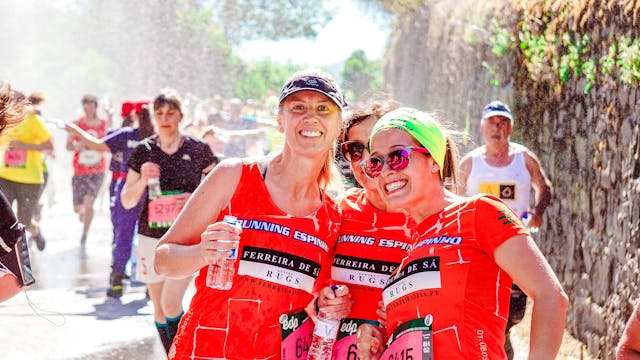10 Steps to Sidestep Gastrointestinal Distress for Athletes + My personal Fueling Plan

A review from Never Second and my personal pre-race and race day nutrition plan.

10 Steps to Sidestep GI
Navigating Away from GI Discomfort: Tips for the Endurance Athlete
Endurance sports push the human body to its limits, not just in terms of muscle and stamina but also in gastrointestinal resilience. Gastrointestinal problems, commonly abbreviated as GI issues, are an athlete’s nemesis, often capable of derailing months of diligent training in the span of a single race. While the complete understanding of GI issues in athletes remains a work in progress, there are several strategies to mitigate the risks. Not every method will suit every athlete, but within these ten steps, there may be solutions to keep your gut as enduring as your spirit.
1. Lay Off High-Fiber Foods Pre-Competition: High-fiber foods are excellent for keeping the bowel regular but can be counterproductive close to race day. They may increase bowel movement frequency and gas production during exercise, which is less than ideal. Opt for low-fiber, “white” carbohydrates like plain pasta and white rice instead.
2. Opt for Sports Nutrition with Neutral pH: Acidity in sports drinks and gels, often heightened to extend shelf life, can exacerbate GI issues. Seek out sports nutrition products with a neutral pH, like Neversecond’s C30 Sports Drink, to keep the stomach settled.
3. Embrace Multiple Transportable Carbohydrates: Consuming carbs in combinations (such as glucose with fructose) can lead to more effective absorption and reduce GI distress, especially in higher quantities. All Neversecond C-Series products, for instance, use this beneficial mix.
4. Avoid ‘Slow’ Carbs: Carbs that take longer to absorb linger in the GI tract and can lead to discomfort. Keep them to a minimum, especially during a race.
5. Shun Aspirin and NSAIDs: These medications can increase intestinal permeability and should be avoided pre-race to prevent compromising the gut’s protective functions.
6. Steer Clear of Lactose: Even mild lactose intolerance can lead to problems during physical exertion. Consider lactose-free or alternative milk products like soy or almond milk.
7. Avoid Fructose-Only Foods: Fructose, if consumed as the sole carbohydrate source, is notorious for causing GI issues. Limit intake of high-fructose fruits and juices before and during a race.
8. Prevent Dehydration: Dehydration can worsen GI symptoms. Begin your race well-hydrated to keep the GI tract functioning properly.
9. Test Your Nutrition Strategy: Never try a new nutrition plan on race day. Practice your pre-race and race-day nutrition to discover what works best for your system.
10. Train Your Gut: Acclimatizing your gut to the foods and amounts you will consume during a race can reduce the chances of GI problems. Regularly consume carbohydrates during training to keep your gut’s carbohydrate absorption capabilities in peak condition.
Incorporating these steps into your training regime and pre-race preparations can make a world of difference. And while these tips are rooted in my experience and the limited research available, they are also bolstered by the success stories of many athletes who’ve turned their once turbulent GI issues into a tale of tranquility.
For those seeking specific product recommendations, I endorse Neversecond’s C-Series, designed with the athlete’s gastrointestinal comfort in mind.
Remember, when it comes to gastrointestinal health, the best offense is a good defense. Plan, practice, and you’ll not only cross the finish line, but you’ll do so with your gut as your ally, not your adversary.
Pre-Race and Race Day Carbohydrate Loading Plan
4 Days Before the Race:
- Cease consumption of high-fiber foods.
3 Days Before:
- Increase carbohydrate intake at breakfast and the afternoon snack.
Breakfast:
- 1 and ½ servings of carbohydrates.
- 2 bananas.
- 1 serving of milk or substitutes.
Afternoon Snack:
- Yogurt or substitutes.
- 1 fruit OR 1 serving of carbohydrates (approximately 24g of carbs).
- Include granola.
2 Days Before:
- Increase carbohydrates at snack time and lunch.
Lunch:
- Limit whole grains.
- Prioritize carbohydrates over vegetables (it’s okay if there are no vegetables).
- 1 serving of fish or 4-5 substitutes.
- 1 serving of oil.
- 1 fruit.
Snack:
- 1 slice of white bread.
- 1 guava sandwich.
Day Before the Race:
- Increase carbohydrates at all meals.
- Load with Never Second C90 HIGH CARB DRINK MIX.
Dinner:
- No protein.
- Only carbohydrates, preferably pasta.
Race Day:
Breakfast:
- 1 and ½ servings of carbohydrates.
- 2 bananas (Separate the intake: one upon waking up and the other to carry for the race, to be consumed if necessary up to an hour before).
- 1 serving of milk substitutes.
- 2 tablespoons of sugar.
Hydration Loading:
- Dissolve Never Second C30 SPORTS DRINK in water to consume as far from the start time as possible, allowing time to urinate any excess (perhaps a glass before breakfast and another about half an hour later).
- Note: add a single serving of LMNT Electrolytes if the temperature will be higher than normal.
Carb Loading with Never Second C90 HIGH CARB DRINK MIX.
- A shot of nitrate, just before the race. The one I use: Styrkr Gel30 Nitro+ Nitrate.
Gels During the Race:
- Immediately upon starting to run: Never Second C30+ ENERGY GEL – ESPRESSO.
- The next gels should be consumed no less than 30 minutes apart and no more than 45 minutes apart. For example:
- (1) @ 40’ – 7 to 8km (ESPRESSO)
- (1) @ 1:20’ – 15 to 16km (Regular from here onwards. Until this point suitable for a half marathon).
- (1) @ 2:00’ – 23 to 24km
- (1) @ 2:40’ – 30 to 31km
- (1) @ 3:20’ – 38 to 39km
This plan is personalized and includes products and practices that I personally recommend and find effective. It’s crucial to test your nutrition strategies during training runs to ensure they suit your body’s needs and help you maintain optimal performance throughout the race.
Disclaimer
The information provided in this blog, including recommendations for pre-race carbohydrate loading and nutritional strategies, is based on personal experiences, anecdotal evidence, and limited research. It is intended for educational purposes only and should not be considered as medical advice or a substitute for professional dietary counseling.
Individual nutritional needs and responses to dietary intake can vary widely. The products and practices mentioned are ones that I personally endorse and use; however, they may not be suitable for everyone. It is essential to consult with a healthcare provider or a sports nutritionist before making significant changes to your diet or embarking on a new nutrition plan, especially if you have underlying health conditions or specific dietary requirements.
Always test any new nutritional strategy well before race day to assess your body’s tolerance and response. The author and this platform are not responsible for any adverse effects or consequences resulting from the use of any suggestions, products, or procedures discussed on this site. Users should proceed with caution and at their own risk.
Ready to transform your running? ????????♂️ (click here)

